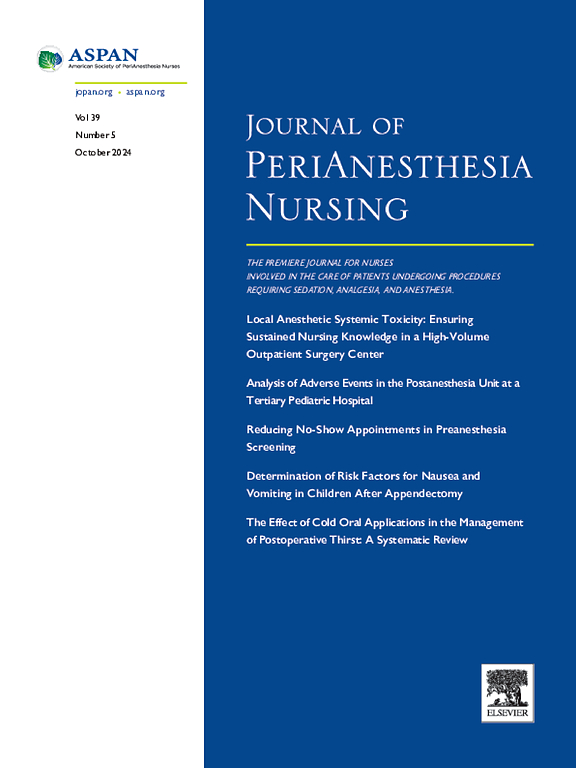通过儿科麻醉前呼吸风险培训提高围术期效率。
IF 1.6
4区 医学
Q2 NURSING
引用次数: 0
摘要
目的:这项针对注册护士(RN)麻醉前电话访谈的流程改进采用了一套循证干预措施,以提高围手术期的效率。首要目的是减少注册护士在术前电话家属外联访谈中对小儿上呼吸道感染(URI)症状的主观性,以便及早发现可能导致取消手术日(DOS)的呼吸道疾病:设计:采用前测后测的循证流程改进设计:方法:向护士电话呼叫人员提供关于儿科麻醉前呼吸风险培训的电子学习模块。麻醉科创建了儿科尿毒症算法,并使用当前体征和症状、发病、肺部疾病、气道装置、手术(COLDS)评分,这是针对有尿毒症症状的儿童的麻醉前风险评分,用于就尿毒症症状向麻醉科咨询。根据 "情况-背景-评估-建议 "制作的麻醉科会诊卡用于简化与麻醉科主治医生的会诊。我们从质量报告卡中获得了过去 24 个月中通过术前电话和 DOS 取消病人疾病治疗的预测数据。计划-执行-研究-行动的周期为 10 周:结果:完成电子学习模块后,护士对自己识别麻醉咨询需求能力的信心达到 92%。因病人生病而取消手术的比例比 2021 年下降了 10%,比 2022 年下降了 7%。术前电话确认患者疾病的取消率比 2021 年增加了 10%,比 2022 年增加了 7%。通过术前电话早期识别疾病来减少术前准备取消率,可避免手术室时间损失、患者和家属对术前准备取消的不满,并为手术和麻醉提供更安全的时间框架:结论:完成电子学习模块后,护士对麻醉科会诊协议的信心很高。对护士工作流程的改进提高了围手术期的效率,这一点可以从测试前和测试后的数据对比中得到证明,这些数据表明,DOS 病人病情取消的情况减少了,术前电话病人病情取消的情况增加了。本文章由计算机程序翻译,如有差异,请以英文原文为准。
Improvement of Perioperative Efficiency via Pediatric Preanesthesia Respiratory Risk Training
Purpose
This process improvement to the registered nurse (RN) preanesthesia telephone call interview applied an evidence-based bundle of interventions to improve perioperative efficiency. The overarching aim was to decrease RN subjectivity regarding pediatric upper respiratory tract infection (URI) symptoms during the preoperative telephone call family outreach interview to allow for early identification of respiratory illness that could lead to a day of surgery (DOS) cancellation.
Design
The design was an evidence-based process improvement with a pretest post-test design.
Methods
An E-learning module, on pediatric preanesthesia respiratory risk training, was delivered to the RN telephone call staff. An anesthesiology-created pediatric URI algorithm with use of the Current signs and symptoms, Onset, Lung disease, airway Device, Surgery (COLDS) score, a preanesthetic risk score for children with URI symptoms, were used to trigger consultation with anesthesiology for URI symptoms. Anesthesiology consultation cards following situation-background-assessment-recommendation were used to streamline consultation with an anesthesiology attending physician. Predata were obtained from the Quality Report Card on patient illness cancellations made both on the preoperative telephone call and DOS from the previous 24 months. A plan-do-study-act cycle was completed over 10 weeks.
Findings
RNs' confidence in their ability to recognize the need for anesthesiology consultation was 92% after completion of the E-learning module. The rate of DOS cancellations for patient illness decreased by 10% from 2021 and 7% from 2022. The rate of preoperative telephone call-identified patient illness cancellations increased by 10% from 2021 and 7% from 2022. Decreasing DOS cancellations by early identification of illness on the preoperative telephone call is preferred to avoid loss of operating room time, patient and family dissatisfaction with a DOS cancellation, and provide a safer time frame for surgery and anesthesia.
Conclusions
RNs’ confidence in anesthesiology consultation protocol was high after completion of the E-learning module. The process improvement to the RN workflow resulted in improved perioperative efficiency as evidenced by comparison of pretest post-test data indicating a reduction in DOS patient illness cancellations and an increase in preoperative telephone call patient illness cancellations.
求助全文
通过发布文献求助,成功后即可免费获取论文全文。
去求助
来源期刊

Journal of Perianesthesia Nursing
NURSING-
CiteScore
2.20
自引率
17.60%
发文量
279
审稿时长
90 days
期刊介绍:
The Journal of PeriAnesthesia Nursing provides original, peer-reviewed research for a primary audience that includes nurses in perianesthesia settings, including ambulatory surgery, preadmission testing, postanesthesia care (Phases I and II), extended observation, and pain management. The Journal provides a forum for sharing professional knowledge and experience relating to management, ethics, legislation, research, and other aspects of perianesthesia nursing.
 求助内容:
求助内容: 应助结果提醒方式:
应助结果提醒方式:


